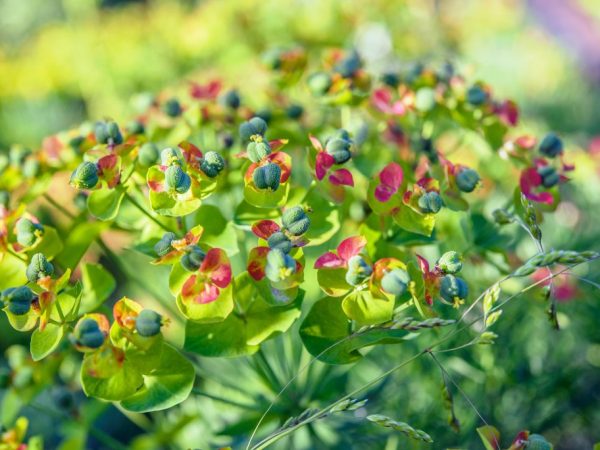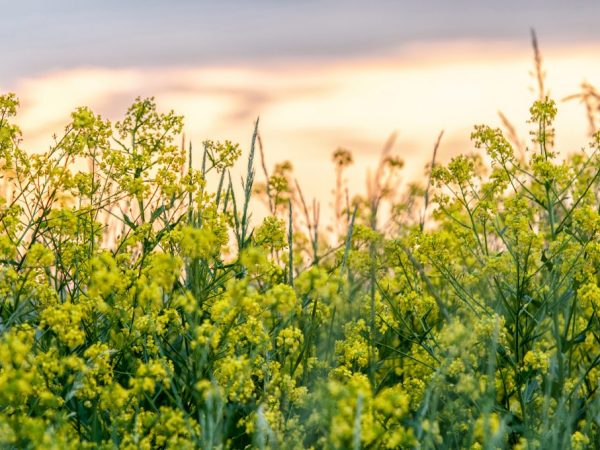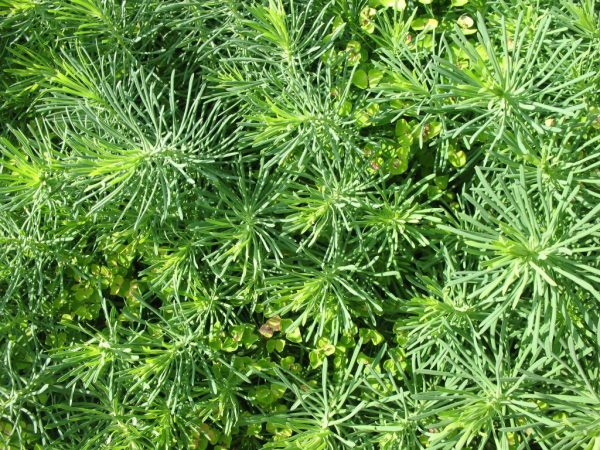Cypress spurge - the most spectacular and unpretentious ground cover plant
Cypress spurge is a paradoxical flower. On the one hand, it is a plant-aggressor, banned in many countries, and on the other, it is a landscape designer's dream. It is considered one of the most effective bio-agents for skin treatment, and at the same time, it has a detrimental effect on horses and cows.
- Origin
- Description
- Leaves and flowers
- Roots
- Purchase and adaptation
- Landing
- Transfer
- The necessary conditions
- Selection of soil and location
- Humidity
- Temperature
- Lighting
- Home care
- Fertilizers and feeding
- Watering
- Use in landscape design
- Containment of aggressiveness
- Reproduction methods
- Seeds
- Cuttings
- By dividing the bush
- Vegetative regeneration
- Diseases and pests
- Useful videos

Cypress spurge
Origin
The history of this flower is 3500-3000 years old. His image is found in the excavations of the Bronze Age in Central Europe. Later, it spread throughout Europe, with the exception of the northern part, and also in Asia (Turkey). Introduced to the USA in 1860 as an ornamental plant.
Euphorbia cyparissias is the biological name of the cypress-leaved milkweed.
The plant has adapted to a wide range of growing conditions. At first, it was used as a cover flower on graves. Hence the popular names:
- spurge in the cemetery;
- cemetery moss;
- crown of Bonarpart.
Grows in rare forests, on roadsides and on pastures in Western Europe and the USA. Euphorbia cyparissius is toxic to horses and cows and fatal to fish.
It is listed as a noxious weed by the North American Department of Agriculture and banned from cultivation in the states of Colorado, Connecticut, Massachusetts and Wisconsin, but despite the strict ban, the plant continues to be planted as an ornamental.
It is from the cypress milkweed that such a concept as a sensory garden originated - its fluffy stems are so beautiful and incredibly soft foliage is so pleasant to the touch. According to landscape scientists, this is one of the most spectacular cover species, moreover, unpretentious, plastic and with an excellent growth rate.
Description
Euphorbia cyparissias is a vigorously spreading rhizomatous perennial plant with upright stems up to 30 cm tall, with very narrow blue-green leaves resembling cypress needles.
Leaves and flowers
In the lower part, the stem is unbranched, covered with short, tightly appressed scaly leaves 2.5-3 cm long. In the upper half, forms lateral, densely leafy shoots ending in an umbellate inflorescence of 10-18 greenish-yellow flowers, turning orange on poor soils. In good weather, it blooms again in early autumn.
Flowers are arranged in pairs (female - on a short stem above the male flower). Sepals and petals are missing on them. Under flowers with a diameter of 3 mm - yellowish-green bracts 6 mm in diameter.
Female flowers produce fruit in the form of a capsule of 3 sections, about 3 mm in diameter, each containing 1 seed. When ripe, the seeds "shoot" at a distance of up to five meters from the plant.
Roots
The root system consists of:
- from a taproot growing vertically down to a depth of 3 m;
- lateral roots with additional buds capable of forming new shoots.
Extensive root systems and early spring growth allow seemingly weak deciduous shoots to compete for space, nutrients, water and sunlight, crowding out other plants.
If the cypress euphorbia is not limited, by the age of 5-6 it will cover an area with a diameter of 1.5-2 meters with a dense carpet.
All parts contain toxic latex, which irritates the mucous membranes, gastrointestinal tract and causes dermatitis on contact in some people.
It was once used to treat freckles, eliminate warts and skin ulcers, and for hair growth. With the development of cosmetology, the need for it has disappeared.
Purchase and adaptation

Seedlings easily adapt to a new place
The plant goes on sale both in a container with a formed bush, and in the form of one stem and part of the rhizome.
A seedling with a closed root system (ZKS) can be planted in open ground at any time of the year, the only condition is no later than 2 months before the onset of permanent frosts.
The stem with an open root system (ACS) needs adaptation operations.
For this you need:
- remove dried roots;
- immerse the stem in the root solution for several hours.
Landing
The seedlings do not have a pronounced main rhizome; they are placed in shallow (up to 5 cm) grooves with drainage at the bottom, straightening the lateral roots.
Sprinkle on top with light earth, slightly compact and moisten the soil surface.
When planting an adult plant with a taproot, a hole is dug 30-40 cm deep. This is followed by similar operations.
Transfer
You can transplant both a mother plant with a powerful taproot, and rooted parts with lateral rhizomes.
To do this, they chop off the roots with a sharp shovel, dig in the euphorbia and, together with a lump of earth, transfer it to a prepared place.
If the vertical rhizome could not be completely dug out, then new shoots will soon go from it.
Optimal time for transplant:
- early spring, before the start of sap flow;
- autumn, 1.5 - 2 months before persistent cold weather, so that the plant can take root.
The necessary conditions
Euphorbia has settled in open areas with poor soil: pine forests, hills, fields. Its natural habitat is limestone, sandy or gravelly soils. It is drought tolerant and loves the sun, but tolerates partial shade.
Selection of soil and location
For planting in the euphorbia garden, you need a dry, sunny place with a rocky loose substrate. She will feel great in rock gardens, mixborders, arabesques.
This plant does not tolerate:
- constantly damp soil;
- nearby groundwater;
- stagnant moisture after melting snow or rain.
Therefore, they choose an elevated place for planting, with poor rocky or sandy soil and good drainage.
Humidity
The plant is drought-resistant. It calmly tolerates a long absence of watering due to:
- narrow leaves through which moisture evaporates weakly;
- a long taproot that extracts water from a sufficient depth.
In a period of insufficient moisture, the spurge is able to store it mainly in the rhizome.
Confirmation of this is the data provided in the FEIS Fire Interaction Information System (USA):
- with a decrease in watering, the number of rhizomes in the plant increased;
- the thickness of the main stem increased by 15%.
At high air temperatures, it is enough to moisten the soil around the flower every 7-10 days.
Excessive moisture is detrimental to milkweed. It can lead to the death of the plant.
Temperature
The small cypress tree survives in a wide temperature range, from 40 ° C to -25 ° C. During hot weather, it must be additionally moistened, and before the winter cold, the entire above-ground part must be cut off.
Even if the stems of the plant dry out in a sultry summer or freeze in winter, the euphorbia will revive from dormant buds on horizontal roots.
Lighting
Like any plant, euphorbia loves the sun. Its decorative qualities are fully developed in a sunny place:
- needle leaves densely cover the stem, creating a fluffy dense shoot;
- stems are low, strong, growing vertically;
- the color of leaves, stipules and flowers is saturated;
- the shape of the bush is symmetrical, spherical.
In a light shade, these qualities are mainly preserved, however, the intensity of color decreases, and the height of the stems and the distance between the rows of leaves on them increase.
In the shade, the stems grow long and weak. The bush is falling apart, losing its shape. The color of all parts of the plant becomes faded.

Grows well in the open sun
Home care
Fertilizers and feeding
An excess of organic matter and nitrogen in the soil leads to a deterioration in the decorative qualities of cypress euphorbia - the shoots become long, weak, lodging. As a result, the number of leaves per unit area of the stem decreases, it looks "naked".
To give splendor and compactness, it is recommended to use potash and phosphorus dressings, but no more than 2 times per season:
- at the beginning of the growing season - potassium nitrate, potassium sulfate;
- in the fall - superphosphate.
On poor soils or with long-term cultivation in the same place, you can scatter a complete complex fertilizer in early spring, even over the snow, at the beginning of its melting.
The nitrogen content in spring should not exceed 20%. Optimal mixture for fertilizing NPK 20-20-20.
Watering
Garden spurge is watered as the surface layer dries completely.
When watering this plant, they adhere to the principle "It is better to underfill than to overflow." You should be especially careful so that the water after irrigation does not stagnate around the euphorbia.
Use in landscape design
Cypress spurge brings a delicate and delicate texture to the garden composition.
Due to its dense foliage to the ground, the stem can be used as a foreground flower. It goes well with conifers - undersized spruce, juniper and fir. But the euphorbia bushes themselves look great, and at any time of the year.
With these plants, garden compositions become elegant and impressive, especially on a rocky area in a rocky garden.
To make the spurge always look decorative, it must be cut regularly. The first time this operation is performed after the end of flowering, but before the formation of fruit pods. Then the haircut is carried out as the shoots grow or to maintain the given shape. As a result of pruning, the bush becomes denser and fluffier.
Containment of aggressiveness
To prevent the spread of cypress milkweed throughout the site, it is planted in buried pots or the growth area is limited with special dug-in barriers.
Reproduction methods
Euphorbia cyparissias has great breeding potential.
At home, the following methods are used:
- seminal;
- vegetative (cuttings);
- regenerative (through fragments of rhizomes, horizontal roots).
As biology students at the University of Roy Island have discovered, any broken piece of cypress milkweed can vegetatively reproduce.
Seeds
Seeds can be sown both before winter, covered with a 2-cm layer of loose substrate, consisting of garden soil and sand, and in early spring. Seeds are not stratified before planting.
Cuttings
The optimal time for cutting: late May - early June. For cuttings, young shoots with more than 20 leaves are chosen.
Next, perform the following operations, always wearing protective gloves:
- cut off with a sharp knife the upper part of the stem with 10-15 leaves;
- wash off the latex layer from the handle with warm water;
- fall asleep with crushed activated carbon the place of cut of the cutting and mother plant;
- cut twigs are placed in heat to dry for 1-2 days;
- planted in a mini-greenhouse.
The planting container is filled with a drainage layer (2-3 cm), then with soil in equal proportions:
- garden soil;
- sand.
It is helpful to add a few crushed activated charcoal tablets.
The soil should be slightly moist: euphorbia does not tolerate excessive moisture.
After a month, the cuttings will take root and can be planted in the garden. To keep the roots strong and healthy, use root-forming solutions - Kornevin, Heteroauxin.
By dividing the bush
If euphorbia is already growing in your garden, it is most convenient to propagate it by dividing it. The operation is carried out in April-May, when flowering begins.
No special skills are required here: there are at least 2 kidneys on each section.
You just need to separate the cut along with a part of the horizontal root and transplant it to a previously prepared place.
Vegetative regeneration
Shoots can develop from any, even deeply buried, part of the root. Roy Island University students noted how from 2 parts living roots grew the following year:
- 240 branches from the main rhizome;
- 160 - from horizontal.
The most rapid reproduction of cypress-leaved milkweed is through regeneration.
Diseases and pests
Euphorbia is practically not affected by diseases. He can die only from a prolonged excess of moisture.
White milky juice perfectly protects it from single pests, however, in case of epidemics, insects can attack the plant
| Name of defeat | Signs | Prophylaxis |
| Fungal diseases | Mealy bloom on leaves and stems, rust, ugly twisted stems. Rare. | Exclude high humidity and contact with diseased plants. Treat with fungicides. |
| Whitefly | Colonies of sedentary larvae on the back of the leaf | Reducing humidity, insecticide treatment. In the initial stage - with soapy water. |
| Spider mite | The stem is shrouded in cobwebs. | |
| Nematodes | The leaves turn yellow and fall off, the shoots are bent. | Phosphamide treatment. |
| Scorms | The plant is covered with a powdery bloom, lumps of pest eggs are visible. |
This flower grows in the garden without your participation. Even an inexperienced florist gardener can take care of him, creating incredibly beautiful compositions with his help.
The aggressiveness of euphorbia can be easily suppressed by regularly cutting off the growing roots. And then your garden will delight guests and households with its elegance and charm.

